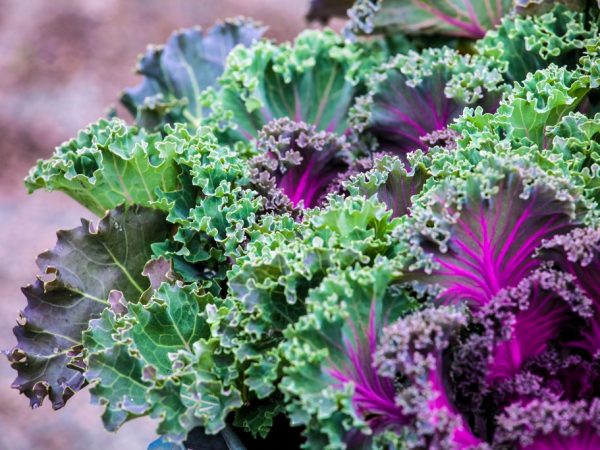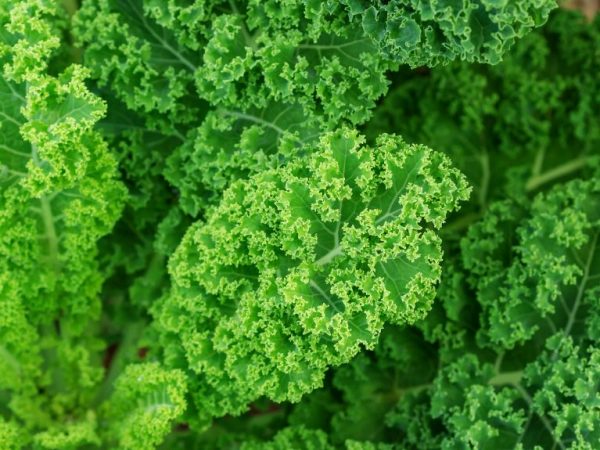Description of Kale cabbage
Kale cabbage appeared in our country recently. It is grown for decoration of the site and for eating. You can grow Kale cabbage even in the cold season.

Description of Kale cabbage
Variety characteristic
Kale is an annual herb that does not have a head of cabbage. The vegetable has short stems. The foliage has 2 tiers and is on cuttings. The appearance of the cabbage is unusual. The leaves are curly, waves are visible at the tips. Only leaves are suitable for food; stems and petioles are inedible. Animals can eat the whole vegetable.
The plant is green, red, gray, purple. The color depends on the variety, so the plant is often grown in flower beds as a decorative element. The size of the bush reaches a height of 25-50 cm. After the vegetable is ripe, some of its leaves are torn off, and the plant continues to bear fruit. It is added to soups, stewed, and salads are made from it.
Variety of varieties
Thanks to breeders, there is a large selection of Kale collard greens.
- The most famous species is Kale Curly.
- The Tuscan Kale variety has a soft green foliage.
- Cold-resistant species - Premier.
- The Siberian variety has a strong immunity to pests.
- Red Russian cabbage. The Russian species has a bright red to purple leaf color.
- Redbor F1 collard greens are often used to decorate dishes.
- Reed cabbage is distinguished by its enormous size (up to 190 cm in height).
Beneficial features
Kale collard has invaluable benefits for the human body. A vegetable can even replace meat.
- The plant contains a lot of calcium: 1.35 ml of an element per 1 g. Vegetable calcium is quickly absorbed in the body, and not the one contained in dairy products.
- 200 g of foliage helps to stock up on the daily protein requirement. The same amount is found in meat.
- Each Kale variety is a natural antioxidant.
- The vegetable is recommended for those who are losing weight. 100 g of the product contains only 50 kcal.
Growing
Growing Kale collard is a simple process, but you should familiarize yourself with its features. The plant has a low survival rate, so it is better to sow seeds directly to an open area. If the gardener devotes as much time as possible to the seedling growing method and follows all the necessary rules, it will be possible to harvest a good and tasty harvest.
Seedling growing method

The plant needs good lighting
Growing seedlings occurs in stages.
- 40-50 days before planting in open ground, seeds are sown for seedlings. Take individual pots and fill them with nutrient soil. 2-3 seeds are placed in each container.
- The seeds are immersed in the ground to a depth of 1 cm; if it is deeper, the stems will not appear for a long time.
- In order for the seedlings to grow at the same time, the necessary conditions for growth are created for them. The air temperature must be at least 24 ° C. The containers are covered with foil until the first shoots appear.
- The seedlings are then grown at 16 ° C.The plant needs lighting at all stages of development.
Seedlings are ready for picking after 6 weeks. By this time, its foliage becomes noticeably curly. The pick is carried out carefully so as not to damage the roots.
Soil preparation
To grow Kale leafy cabbage without any problems, you need to prepare the soil. It is advisable to select a site after legumes, tomatoes, potatoes or cucumbers. The land is prepared in the fall. Humus, compost and mineral fertilizers are added to it. All components are applied at 3 kg per 1 sq. m. The acidity of the soil should range from 5.5 to 6.8 pH. It will be difficult to check it yourself, so you can track the acidity by the presence of weeds on the site. If woodlice grows in large quantities, add granular sulfur, if not, compost.
The landing site should be sunny or with partial shade. Sowing is carried out in April so that the earth warms up to 5 ° C.
Care
If you choose the right planting place, without winds and with normal lighting, the growing process will be simple.
Watering
Watering is carried out abundantly, especially during the hot period. The plant loves moisture, so it is worth making sure that the soil is always moderately moist. After each watering, the soil is loosened. If foliage dries up, they are immediately removed to prevent insects from appearing.
Fertilizers
The soil is fed every 6-8 weeks, starting from the amount of the harvested crop. The plant should not be overfed as the leaves will start to rot. For top dressing, a solution of mullein, chicken droppings, wood ash and herbal solution is used. After watering, the vegetable is sprinkled with dry ash.
To prepare the infusion, 10 kg of grass, 2-3 kg of droppings or mullein are taken for 100 liters of water. The solution is insisted for a day.
Diseases and pests
The plant often suffers from insects such as sawflies, scoops and flies, aphids and fleas, slugs and caterpillars, worms and flower beetles. Harmful insect control measures:
- every day they powder the foliage with ash or tobacco;
- sprayed with vinegar or a solution of chicken droppings;
- douse the foliage with iodine or ammonia;
- use chemicals if the instructions are followed.
As chemicals suitable "Bankol", "Kemifos", "Fury", "Sharpei", "Aliot" and others. To prevent diseases and insects from appearing, it is important to remove weeds on the site and adhere to all the rules during watering and fertilizing.
Conclusion
The vegetable has an excellent appearance, taste, and also has a huge number of useful properties. It is easy to grow a good harvest without a lot of effort. Both experienced gardeners and beginners in this business will be able to cope with the process.

